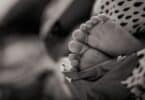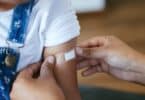 The North Shore University Hospital in Manhasset, was busy last month delivering 7 sets of triplets, a record for the facility that had just 11 in all of last year.
The North Shore University Hospital in Manhasset, was busy last month delivering 7 sets of triplets, a record for the facility that had just 11 in all of last year.
At a news conference Tuesday at the hospital, three pairs of new triplet parents looked tired, but they glowed as they described their experiences.
“We weren’t expecting triplets; it wasn’t planned,” said Ross Rinaldi, 37, of Whitestone, who sings Irish songs to his son, John, and two daughters, Noreen and Patricia. “When I found out I was getting triplets, I knew I needed a bigger home.”
At least one set of triplets born at the hospital was conceived without the use of fertility drugs, but most of the parents had used those treatments, doctors said.
Stacie Sakellis, 35, of Flushing, said she and her husband, Demetrios, 33, had been trying to conceive for more than two years when, with the help of fertility treatment, she became pregnant with triplets.
“It was the biggest shock when the doctor was doing the sonogram,” she said, laughing. “First he saw one, then he saw two, then he saw three. I told him to stop. I didn’t think I could take it anymore.”
Like most triplets, all seven sets were born prematurely and could face health problems, said Dr. Michelle Smith-Levitin, director of the hospital’s high-risk pregnancy center.
So far, none of the babies or their mothers have encountered serious health setbacks, and only one set of triplets has left the hospital. Three more babies, not all from the same set, were scheduled to leave yesterday.
Rates of triplet births have risen nationally since 1980 by as much as 500 percent, according to Smith-Levitin, in part because of the use of fertility drugs. But the U.S. Centers for Disease Control and Prevention reported that in 2004, the last year data were available, there was a 5 percent drop in triplet births to 176.9 per 100,000 live births, down from 187.4 the year before. And, despite modern health advancements, triplet pregnancies and births remain risky.
Triplets, like all premature babies, are prone to infection, as well as breathing and feeding problems, said Dr. Richard Schanler, chief of neonatology at the hospital. And more demand is placed on the mother, who must produce three times the normal amount of milk if the mother breast feeds.
The seven triplet births posed challenges for the hospital. Schanler said three delivery teams, each consisting of a doctor, a nurse and a respiratory therapist, were on hand for the birth of each triplet set. Parents seek out North Shore because of its reputation as a hospital that performs high-risk births, Schanler said.
As the hospital stays near an end for some babies, seven sets of parents prepared to bring their new triplets home.
Most said they have their nurseries ready, their triplet strollers waiting and supplies stockpiled.
Michele and Patrick Barbo of Greenlawn say they have loaded up on diapers as they wait for their babies.
“We’re hoping that in the next two weeks, they’ll come home,” said Michele Barbo, 33, who gave birth on June 11.
Do you remember when seeing a set of twins, triplets or quads was a rarity? Those days are long gone…It was funny to watch the video interviews with the parents when they said how ‘shocked’ they were that there were so many babies in there. They knew that there was a chance that multiples could occur during their fertility treatments, but didn’t believe that it could happen to them.
Does no one read the papers anymore?? Last year alone there was approx. 7,000 sets of triplets born in the U.S., with only approximately 2,100 of them occurring naturally.
That is a lot of parents who thought that it could only happen to someone else…






